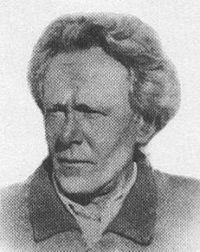
Guido Lupo Maria De Giorgio, pseudonym “Havismat” (San Lupo, October 3 1890 – Mondovi, December 27, 1957) was an esoterist and Italian writer.
After graduating with a degree in philosophy, he went to Tunisia where he worked as a teacher of Italian. There, he came into contact with Islamic esoterism through a local brotherhood. He then moved to Paris after WW I, where he got to know Rene Guenon. He backed his friend, collaborated with him by writing articles for the two major French esoteric journals of the time: Le Voile d’Isis and L’initiation.
He returned to Italy in the 1920’s and participated in the Gruppo di Ur, writing under the name Havismat. In 1930, he joined with Julius Evola in promoting the journal La Torre, in which he came up with a theory of a type of Sacred Fascism with the effort to universalize the Fascist movement in an esoteric way.
In La Tradizione romana (The Roman Tradition), de Giorgio accused Europe in the aftermath of WW II of have become scientistic and of stifling the spiritual research of man. The solution, according to de Giorgio, lay in returning to an ancient conception of spiritual and temporal authority. A typescript version of this work, whose original title was “The dead badge of power. Introduction to the doctrine of Roman Sacred Fascism”, was given to Benito Mussolini for Christmas in 1939.
In Dio e il Poeta (God and the Poet), de Giorgio poured out his mystical experience arising from his ascetical practices.
None of his works was published during his lifetime, some posthumously and others still unpublished.
Julius Evola
In Cammino del Cinabro, Julius Evola describes Guido de Giorgio.
He was a type of initiate in the wild and chaotic state, he had lived among the Arabs and personally knew Guenon, who held him in high esteem. He was a man of exceptional culture, he knew several languages, but he had a rather unstable temperament and strong passionate positions, emotive and lyrical almost like Nietzsche.
Evola goes on to describe de Giorgio’s erratic personal and love life, his strong personality, then describes their collaborations and even trips together to the Alps. (They both loved the mountains.) Evola conceded that towards the end, they grew apart somewhat due to de Giorgio’s “indulgence in a sort of Vedanta-ized Christianity”. (Apparently, Evola was unaware of La Tradizione romana, which was never published during his lifetime.)
From La Tradizione romana
The restoration that we propose, taking up again the thought, aspiration and ideal of Dante, is a return to the spirit of Rome, not the pure and simple repetition of the past that would unrealizable, because nothing of the contingencies of the world ever repeats itself, but the adhesion to those eternal principles of truth that are contained in the Sacred Books and expressed by ancient symbols.
[To save Europe and the West from catastrophe,] it would depend not as much on the external material things that are of scant value in themselves, but on those deep, internal, spiritual values … the catastrophe of the life of the spirit, the collapse of the truth.
References:
- Wikipedia article
- “Il Cammino del Cinabro”, by Juius Evola
- La Tradizione romana, by Guido de Giorgio
Pingback: A Short Reflection On Realism and Ritual | Seeds of Eudaemonia
Pingback: A Short Reflection On Realism and Ritual | This Rough Beast
Any of his materials availabl in English. Have done some searches but not come up with anything much.